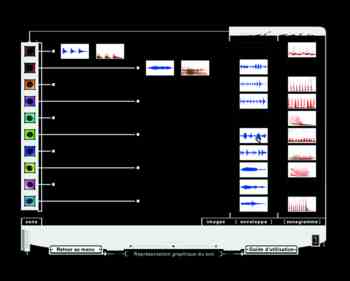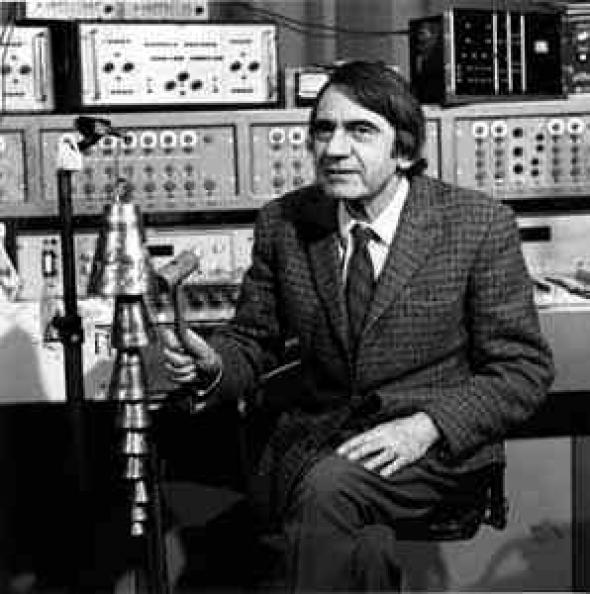Concentrated Listening
In the second half of this month’s Special, Flint Michigan explores the broad church that is ‘musique concrète’. From maths nerds obsessed with seriality to sonic activists standing around in parks with microphones, the avant-garde has gone to very varied lengths to release music from the ivory tower of composition by letting in ‘real world’ sound. But, argues Michigan, too much ‘concrète’ can be just as restrictive CANONMost of the early histories of electronic music take as their starting point two post-war institutions that pioneered experimental perception by means of music: the Groupe Recherche Musicales (GRM), established in Paris in 1945, and the Cologne-based WDR radio studio. Both institutions were interested in moving away from the timbral restriction of orchestral instrumentation and, to varying degrees, a departure from the reliance upon notation. Perceived as restrictions upon perception, these two parameters had already been subverted by those such as Edgar Varèse with his use of percussive timbres and handwound sirens in Ionisation and, more presciently, in both his wish for sound to be studied scientifically and in his often thwarted plans to make electronic music. Both of these wishes were to some degree realised by GRM and WDR. The former, founded by Pierre Schaeffer, was the home of ‘musique concrète’ – a movement that sought to explore the sonorous qualities of objects, inventorise them and to compose using the resultant ‘found sounds’. The latter, the home of ‘electronische musik’, substituted the pure pitches of electricity for conventional classical instruments. However, if GRM and WDR had succeeded in developing new timbres with which to intensify aural perception, the persistent virtuosity that Varese sought to disassemble returned in WDR’s attempts to perfect the mathematics of serialism, and the compositional accents which, with GRM, came to form the ‘spine of narrative’.
DESIRING PERCEPTIONFrom its early days of being a kind of counter-institution the GRM and musique concrète quickly became a canonical alternative. Schaeffer’s A La Recherche d’une Musique Concrète (1952) carried the sub-text that experimentation with sound could be reduced to a methodology. With the emphasis on studying sound objects and on sonorising narratives, the GRM provided a framework that could cushion the affectivity of sound – sound was harnessed to traditional artistic purposes and not to cultural dynamics that could help to change perception, make perception a conduit of desire. For Schaeffer, the musical object, when separated from its context, was to be used ‘according to its familial relationships and the concordance of its characteristics.’ The ‘concentrated listening’ that Schaeffer had hoped musique concrète would deepen had come to focus exclusively on the object, thus reducing the potentiality of aural perception to sound for sound’s sake. Such restrictions not only served to reify musical practice under the auspices of a research program, but also reinforced the authority of the composer to the detriment of the listener. In this light ‘concentrated listening’ comes to imply a scholarly command rather than a mode of intensified listening that is more fitting to the fusion of desire and perception.
ALMOST NOTHINGWith the wider availability of recording equipment and studio technology the institutional control of sound experimentation passed into less didactic hands. Those interested in the ‘found sounds’ associated with musique concrète came to reject the strict confines of the ‘musical object’ as they began to turn the microphone onto the social world around them, extending the notion of music beyond that of the dominant representation of the musical. In this way musique concrète began to mutate into the field recording epitomised by Luc Ferrari’s Presque Rien No.1. Setting his microphone on the window ledge of a bedroom that overlooked the harbour of a Yugoslavian fishing village, Ferrari proceeded to record the sounds in the early hours of the morning: ‘I recorded those sounds which repeated everyday: the first fishermen passing by... events determined by society.’ The resultant piece, frowned upon by his colleagues at GRM, was in many ways an extension of Cage’s 4’33’’: rather than remaining in the auditorium to demonstrate the loudness of ‘silence’ as Cage had done, Ferrari abandoned the legitimation of the institutional site at the same time as he abandoned his identity as ‘composer’ to become a meta-musician. Presque Rien, in setting the ‘composer’ alongside the listener, immerses both in the miniscule sounds of the social. Rather than maintaining desire and perception as mutually exclusive, rather than have compositional form reify the passage of time, Ferrari offers up the informal and infinitesimal creativity of a ‘situation’. As Gilles Deleuze puts it in Cinema 2: ‘between the reality of the setting and that of the action, it is no longer a motor extension which is established, but rather a dreamlike connection through the intermediary of the liberated sense organs.’

SECOND NATUREWith the work of Chris Watson the field recording came to represent the antithesis of the ‘dreamlike connection.’ Rather than mobilising desiring-perception by means of an undirected attentiveness, Watson’s meticulous recordings of natural sounds not only direct percepetion to pre-existing representations, thus creating a ‘sound realism’, they also take their legitimation from the concept of nature as authentic experience. Such a narrowing of focus for musical practice has the effect of severing desire from perception by drawing desire into registering the authenticity of the perceived rather than inveigling desire to alter perception. In this way the senses are not ‘liberated’ to become ‘theoreticians in their immediate praxis’ (Karl Marx), a dialectic of knowing and feeling, but become adjuncts to an inflation of the represented – an overinvestment in that which is already perceivable. With Ultra-Red’s project Second Nature, based around the struggles of gay groups to maintain the open spaces of Griffiths Park in LA, musique concrète came to be inflected with a political intent. From its opening sounds of outdoor love-making we are witness to desire being an immediate component of the sounds themselves.These extend to the ambiences of the park and suggest that the social field which Ultra-Red are recording and altering is the site for diffuse desire; it is space itself that can be cathected, modified, made conducive to desire. Furthermore, as the title of their project suggests, there is a move away from the naturalistic use of an authentic nature and the positing of a second nature. That the sounds are presented to the listener in microscopically altered form not only sensualises perception, but hints at the ‘subtilised’ perception of new desires and new drives. Such a ‘second nature’ is played out in the way that Ultra-Red do not respect the naturalising authenticity of the ‘field recording’, but instead reveal that the natural is produced. Not only is protest made instinctual and homosexuality returned to nature, but the digital exploration of sound sources, brings a fledgling politics of music to the fore: the binding of aesthetic form, the slavishness of canonical legitimation and the escalation of the represented are outflanked in favour of a pursuit of what it is now possible to perceive and alter. Schaeffer’s ‘concentrated listening’ can thus become the sharing of ‘micro-perception’ between producer and listener which, in its abandonment of notation and familiar timbres, is itself productive of a micropolitics of affective linkage – no longer is a divide maintained between composer and listener but both become metamusicians; listeners as operators.
Mute Books Orders
For Mute Books distribution contact Anagram Books
contact@anagrambooks.com
For online purchases visit anagrambooks.com








